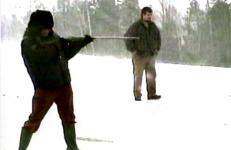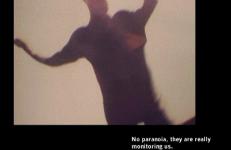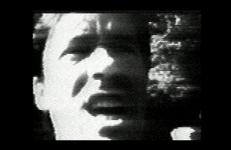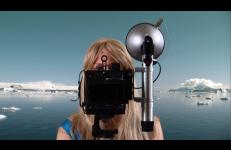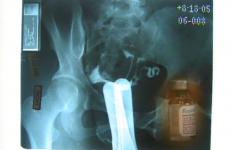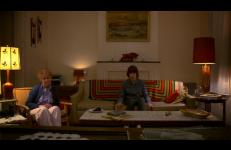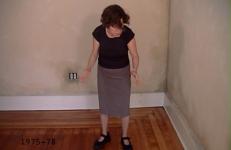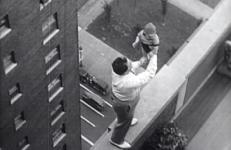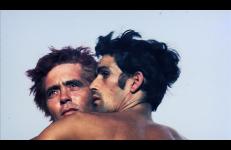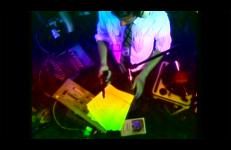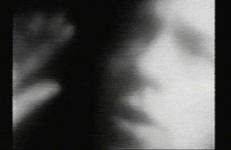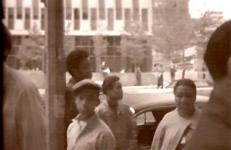Co-commissioned by the Dance Center of Columbia College Chicago and Danspace Project, Death Poem is a meditation on dying. Eiko dances a long solo on a futon under a mosquito net, accompanied by the sound of insects and cicadas. Koma enters from another world and tries to bring Eiko back with him, but he leaves without her, as she is not yet ready to go.
Death and Dying
An avatar, created through a 3D scan of Syms, navigates a plain and vast virtual landscape, the perspective sometimes floating above, sometimes alongside, as she progresses through a perpetual cycle of death and resurrection. Her avatar's journey seems to reflect the spectacularly confusing or nonsensical experience of inhabiting a body during a time of violence and illness that has unceasingly threatened notions of stability and consequentiality, forcing ever-evolving tactics of survival.
Distracted Blueberry follows a performance art band through a series of poetic encounters. Masculine tropes are undone to form a relationship between male sexuality and the human death drive. The body, violence and humour are positioned in the larger context of nothingness and somethingness, bridging a tension between externalized anxieties and the terrors of nature. Evocative of inner emotional states, strange landscapes exist as reflections of our shared dreams and nightmares.
Viewer discretion advised
"This movie was collected for four years before being sprayed scattershot over 28 minutes of psychic mayhem. The line between living and dead is a frontier crossed and re-crossed here. The living are dead while the dead are animated, breathing, swimming, giving birth. Consumed by the animal life of the city, the artist undertakes a first person journey, producing diary notes from one of the most skilled lens masters of the new generation. The camera is her company in this duet of death, the instrument that permits her to see the impossible, the unbearable, the invisible."
The Duet Project: Distance is Malleable is a mutable and evolving series of experiments in collaboration. Negotiating differences of race, time, culture, ethnicity, religion and gender, the artists seek to maximize the potentials of their encounters.
Eiko's grandfather Chikuha Otake (1878–1936) was a praised figure in traditional Japanese painting. But his anti-mainstream sentiments were shunned by the field authorities. His reputation was severely damaged by his failed run for the House of Representatives. Filmed in 2018, at the Philadelphia Museum of Art and the Suiboku Museum in Toyama, Japan, Eiko's edit combines videos of Chikuha's paintings and Eiko's performance with quotes from his essays and Eiko's musings.
Special thank you to David Brick, Ryohei Endo, Hiroyuku Horikawa, Feliece Fischer, and John Killacky.
During 1998 and 1999, Pelon participated in various Internet newsgroups and lists where suicide is the main subject. Stories unfolded as the film was made; some reached the point of no return. The subject of suicide is very candid on the Internet, due to its anonymity and the freedom it allows from the usual taboos around the subject. The newsgroups and lists have become a relatively safe place for the many people that find themselves isolated because of their interest in the idea of suicide.
The fourth collaboration between Jessie Mott and Steve Reinke continues its melancholic musings on desire and mourning, this time with more twerking. Hypnotic backgrounds and eccentric animals lend to its psychedelic children's cartoon vibe, and the signature Madonna and Stockhausen soundtrack enhances the desperation for paradise among those extra long tongues and snake-y bodies.
The fourth collaboration between Jessie Mott and Steve Reinke continues its melancholic musings on desire and mourning, this time with more twerking. Hypnotic backgrounds and eccentric animals lend to its psychedelic children's cartoon vibe, and the signature Madonna and Stockhausen soundtrack enhances the desperation for paradise among those extra long tongues and snake-y bodies.
John Killacky is Eiko's long time friend. It was in July 2018 when both of them were attending the tree planting ceremony of their mutual friend Sam Miller at the Jacob's Pillow that Eiko invited John to join her Duet Project. John proposed to create a video work that they both speak to their dead mothers.
After exchanging their writings, the video was shot and edited by Brian Stevenson in the studios of Vermont PBS on November 22, 2019.
Special thanks to Larry Connolly.
It’s the first day of autumn, and Gibbons can already smell death in the air. Leading us and his dog Woody on a walk through a cemetery, Gibbons voices his obsessive thoughts of death and destruction saying, “I want to be a leaf; I want to fall from a great height and crush whatever I land on.” Waxing weirdly philosophical, Gibbons satirically tries to impress the concept of mortality on his dog; the video, shot in Pixelvision, approximates his dog’s black-and-white vision.
A fantasia that makes twisted use of elements from the Elektra myth and vampire stories. Imagine a woman listening to Richard Strauss's Elektra while watching Carl Dryer's Vampyr and the dream she might then have that night. The protagonist imagines herself as Elektra. She has an unhealthy obsession over her dead father Agamemnon. She also passionately despises her mother Clytemnestra, as she is the one who murdered her father. Elektra exhumes the ax used to kill her father in his bath.
Epilogue: The Palpable Invisibility of Life is the final chapter in The Blindness Series, a body of eight videos on blindness and its metaphors that was begun in 1992. The inspiration for the series came from a 1990 exhibition Jacques Derrida curated for the Louvre Museum, titled Memoirs of the Blind.
An homage to the death of the soap opera, The Evil Eyes is a 1960's era story of a grandmother faced with her mortality, a mother in mid-life crisis, and a son realizing his sexuality - a dysfunctional family whose unspoken angst manifests in the latest episode of their beloved supernatural soap opera, Before Dawn.
The Fancy is a speculative, experimental work that explores the life of Francesca Woodman (1958-1981), evoked by the published catalogues of and about her photographs. Structural in form, the video radically reorganizes information from the catalogues in order to pose questions about biographical form, history and fantasy, female subjectivity, and issues of authorship and intellectual property.
In the spring of 1988, video-maker/activist Gregg Bordowitz tested HIV-antibody positive. He then quit drinking and taking drugs and came out to his parents as a gay man. This imaginative autobiographical documentary began as an inquiry into these events and the cultural climate surrounding them. While writing the film, a close friend was diagnosed with breast cancer and his grandparents were killed in a car accident. The cumulative impact of these events challenged his sense of identity, the way he understood his own diagnosis, and the relationships between Illness and history.
A detective is hired to find the original copy of a lost ancient book. The book recounts the tale of a plague. A form of radiation, unknown at the present time, activates a virus. The virus affects the sexual and fear centers in the brain and nervous system; fear is converted into sexual frenzies which are reconverted back into fear, the feedback leading in many cases to a fatal conclusion.
"On January 22, 1987 an unjustly convicted Budd Dwyer grasped onto the pages of his final speech as Pennsylvania's State Treasurer before shooting himself in front of news cameras. Our current year of armageddon, recession, and occupation resonates as a fitting time to step into Budd's shoes (and perhaps others who sought freedom the same way.) I set up a mini news conference with antiquated, glitchy analog cameras, mixers, players, and decks with the goal of recording Budd's speech in one take.
In Final Exit, an aged one is confronted with his options in blunt terms. Does he want to drag out his existence, increasingly infirm and a burden to his caretakers, or go quietly before resentment overwhelms sentiment? Does he wish to go on living, the quality of his life increasingly diminishing, or be euthanized? Would he prefer cremation or burial? This video confronts the issues of mortality and advancing decrepitude that faces even the friskiest.
The foliage and sprouting of urban greenery becomes the subject of this celebration to all things pollinated. The video explores hidden gardens that lie sequestered amid an array of dwellings inhabited by the not so rich and famous. Felines creep amid the blossoms as human entities enrich the soil with their leaking desires.
The Videofreex conducted this interview with Fred Hampton, the Deputy Chairman of the Illinois chapter of the Black Panther Party, in October 1969, just over a month before he was killed by the Chicago police.
Rare footage of a September 1970 rally honoring the late Fred Hampton, Deputy Chairman of the Illinois chapter of the Black Panther Party. One of the speakers leads the audience in a call and response.
Made in Ireland, October 8th, 2001.
A disorientating experience while attempting to watch the TV news in an Irish hotel room triggers a spontaneous response to the bombing of Afghanistan.
Frozen War is the first episode in the Hotel Diaries series, a collection of video recordings made in the world’s hotel rooms, which relate personal experiences and reflections to contemporary conflicts in the Middle East.
Futures for Failures is a double narrative of failure: architectural and social. Archival footage from a demolition of the Pruitt-Igoe building in St. Louis manifests as the materialization of modernity’s failure. Meanwhile, an intimate voiceover recounts a moment of laughter erupting during a stranger’s funeral, staging anachronous conversation between the disappeared and the disappearing.







